

Over 70% of FMCG categories are predetermined before shoppers enter the store. Most of the items bought in supermarkets are already determined by routine before the shopper walks down the aisle. Yet there's a massive opportunity for 28% of the product purchases where impulse purchasing still reigns. The question is, what categories do shoppers engage with instore?
The Nielsen Category Shopping Fundamentals survey shows more people go to the supermarket to buy milk (57%) than any other item. Now you know why Coles launched its massive $1 a litre own brand milk campaign to grab share from Woolworths. Yet milk is one of the least considered decisions shoppers make at point of sale. Over 70% of shoppers aren't engaged by the category in the store.
It's a similar story for pet food and toilet paper. If you're a marketer of these low engagement instore categories you will get a better marketing ROI from a brand advertising campaign or an incentive before people go shopping.
Low engagement products don't benefit well from instore merchandising
Prospects who are less interested in your product instore are best marketed to out of store. From flyers to shopper dockets, catalogues to mobile promotions driving people to the store you will have better impact than attempting to get their attention while on autopilot in your category aisle. Packaging and instore merchadising is also less likely to switch customers between brands than other categories where people are actually paying attention.
However over half the shoppers surveyed are engaged by the process of shopping, just not with every category. So it follows knowing which category a product falls into helps marketers decide where to best invest in marketing.
The high engagement FMCG categories are frozen snacks and desserts
Shoppers are more engaged by more indulgent purchases like frozen desserts (64%) and infrequent purchases like toothbrushes (64%). Here is a snapshot of what shoppers are looking at with their brains switched off versus on:
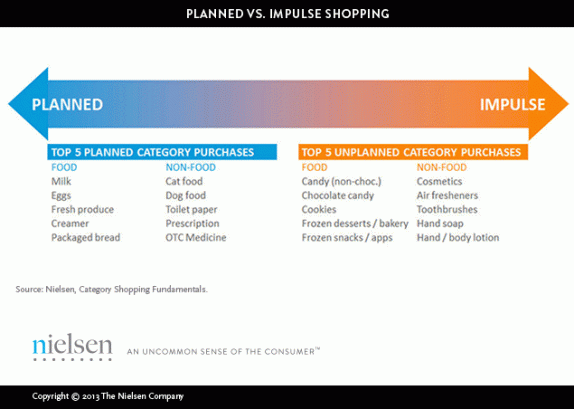
Categories with high engagement are better served by product innovation, instore merchandising and promotions and eye catching packaging.
Our marketing for Pacific West frozen seafood and snacks was centred on creating news and a fresh take on seafood. More adventurous choices has proven to be a more appealing strategy to the predictable product and positioning of Birdseye and I&J. Seven years of year on year growth for Pacific West shows what a difference it makes when you leverage an engaged instore audience.
Read MorePugs & Kisses & Christmas Wishes

(Click to Play)
A sincere thanks to our friends and colleagues for sharing our journey in 2013, UNO’s 13th year growing challenger brands.
We wish you and your family (and all creatures great and small) all the best for 2014.
Once again rather than send cards, we are supporting four koalas through the caring efforts of The Koala Foundation.
Best wishes from the UNO family.
Read MoreAIDS ads that changed our lives: If it's not on, it's not on

Australia faced a big problem in the 80s: AIDS was killing us
In the late 1980s AIDS was spreading unchecked in Australia amongst sexually active adults with multiple partners, homosexual males and intravenous drug users. Most people had no idea how you could catch it and there was no known cure. The only certainty was if you found you had AIDS, it was a death sentence.

The first government advertising campaign to raise awareness of the issue had failed to address the spread of AIDS. While “The Grim Reaper” ads certainly gained attention, the messages had not connected with those at risk and had not changed unsafe sex practices.
Indeed the Grim Reaper had simply scared the general public, especially kids and older people, without offering a compelling safe sex message. In charge of the government's AIDS awareness task force, Ita Buttrose had acknowledged the mistake the Grim Reaper fear campaign had been. The agency responsible that she'd appointed was fired and we were asked to implement our campaign they'd originally passed over for the Reaper.
The creative solution: "next time you go to bed with someone, ask yourself..."
"...how many people are you really going to bed with?"
You can't scare people into doing what's good for them. In fact, it's human nature to reject being told what to do. The art of persuasion often begins with starting a conversation that acknowledges the audience's point of view. And builds from there with an undeniable logic.
This commercial for the first time educated the community it wasn't "other people" who got AIDS, it was potentially anyone who went to bed with someone for unprotected sex.
Shot by Ray Lawrence (who went on to direct Bliss, Lantana and Jindabyne) my AIDS "beds" ad was made before the era of computer generated images. We put 800 real people into 400 real beds in the largest space we could hire in Sydney, the old tobacco bond store in Moore Park. The campaign worked in achieving the brief of raising awareness and driving behaviour change amongst those most at risk. The managers at Ansell would report an uplift in condom sales with every burst of our ads.
It's not often in this business you get the opportunity to really make a difference for society. It's usually baked beans and banking products.
Over three years as lead creative communicator I helped develop a series of undeniable messages that were created for specific audiences. From mass market messages on TV and radio, brochures for distribution in health clinics, English as a second language ads in ethnic press to bus sides and gay street press, posters on beats and stickers on public toilet doors.
The “Beds” ad which asked “next time you go to bed with someone, ask yourself how many are you really having sex with?” gave a graphic explanation of the chain of infection. The “Tell him if it’s not on, it’s not on” ads empowered people to demand their partners wear a condom. On the back of dunny doors in pubs across the country you couldn't ignore the big sticker of a condom clad erect penis with the words: "cover yourself against AIDS"
The outcome: Australia led the world in stopping the spread of AIDS
The integrated advertising campaign successfully raised awareness of AIDS amongst those segments of society most at risk of infection. The messages also reassured those not at risk and transformed the public view from one of “victims of AIDS” to an empowering safe sex message.
The creative campaign was instrumental in educating the public and changing sexual behaviour to succesfully reduce the transmission of the AIDS virus. The leader of Australia's health sector tasked with stemming the epidemic acknowledged the strength of the campaign:
“The message in this war against AIDS is a tough one – we know it will be controversial but we are certain it is the right approach, and it is backed by the World Health Organisation.”
Professor Ron Penny, National AIDS Council, 1988
This AIDS campaign is still recognised around the world as the most effective of it’s kind
Read MoreObstacles to innovation: A jeweller’s tale


Have you read the retail sector is finally looking up? Unfortunately not for everyone.
A friend of mine is one of Australia’s leading luxury jewellers. This year his turnover is down 20% and the word in the trade is over two dozen high-end jewellers around Sydney are on the brink of closure. That’s a lot in such a niche category. What has served them well for decades has seemingly evaporated overnight.
Where have the sales gone? A few years ago no-one had heard of Pandora as a brand of jewellery. Australia is now Pandora's fouth biggest market in the world. Or have you heard of The Iconic as a place to shop for fashion? Last week The Iconic turned over $1,000,000 of online sales in one day.
The simple answer for retail is to go online, right?
My jeweller’s quandary is he opened an online store with a similar offer to his shop and failed to gain any incremental growth.
Global changes demand an innovative response
It’s not just small high-end jewellers suffering from change. The global super premium brands are suffering the curse of ubiquity, Louis Vuitton sales are plummeting despite the increase in purchases of luxury goods by the emerging Chinese millionaire class.
We are increasingly seeing fashion conscious style setters seeking designs from unknown startups, boutique designers that they can tell friends they’ve discovered. Being in the know has more credibility with peers than wearing what any person with a Platinum card can buy in any Gucci store, from Guangzou to Fifth Avenue, Sydney to Roppongi.
Big brands have difficulty innovating as they have an aversion to cannibalising their existing business. It becomes harder the bigger and more established you are, which fortunately gives Australian challenger brands an advantage. The barriers to innovation have been identified in a Australia wide research by the Australian Institute of Management:
What’s stopping Australian businesses innovating

My friend said he had come across an offshore maker of silver jewellery, gold plated with semi-precious stones that look amazing but only retail for $300 to $500. His fear is if he stocked them no-one would continue to pay $3,000 to $5,000 for his similar looking existing product.
My suggestion to my jeweller friend is to take advantage of his ability to be more nimble than a Tiffany. He isn't facing the number one barrier to innovation, a lengthy development time and there is a way he can try something new with minimal risk. If he quickly sets up a small online store under a different brand, he then has no reputation to lose and can test the appetite for this new product.
The ability to test the mix of product and price is easily done with an online store. I’ve written in the past about how we can learn from fashion retailers that are innovating for pricing advantage.
The study shows the upside to trying new ways by becoming an innovator in your category is huge.
Innovation leaders Vs laggers: business performance ratings.
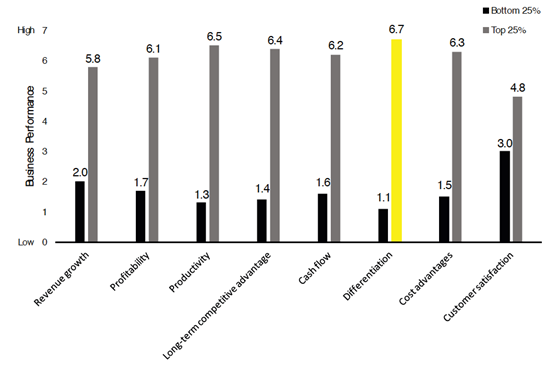
Innovation leaders are two to three times more successful than innovation laggers in terms of growth, profitability, productivity and cash flow. Risk obviously has greater rewards than business as usual. One UNO case study proves the point, Butterfly Silver was the first Australian Jeweller to apply a fashion forward procurement model to become a successful challenger brand.
Source: University of Melbourne and the Australian Institute of Management. 2013
Read MoreSales conversion rates: the facts

Sales call stats – how does your team rate?
48% of sales people NEVER follow up with a prospect.
25% of sales people make a second contact and stop.
12% of sales people only make three contacts and stop.
Only 10% of sales people make more than three contacts with a prospect
So if your sales people are typical of all sales forces, what are the consequences of only 10% of them calling on a prospect more than three times?
Conversion rates increase with sales call rates
2% of sales are made on the first contact.
3% of sales are made on the second contact.
5% of sales are made on the third contact.
10% of sales are made on the fourth contact.
80% of sales are made on the fifth to twelfth contact
Sure, it costs more for your people to call more than 3 times, but consider your return on investment when you factor in the typical conversion rates. Three calls and under only converts 10% of sales!
If your sales people are not following up, the stats indicate there is little to be gained by simply adding new names for them to visit. It also shows the value of building brand awareness before the sales person calls.
Source: Richter10. Thanks to Rick Allen for sharing
Why are most ads so bad nowadays?
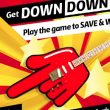

Bartle Bogle Hegarty was the London ad agency every ambitious Australian creative wanted to work at in the 80s. They made a series of great ads for Levis including “laundrette”, came up with "Vorsprung durch Technik" for Audi, "The Lynx Effect" for Unilever and "Keep Walking" for Johnnie Walker whiskey.
BBH creative founder “Sir” John Heggarty will speak at a global advertiser conference in Sydney in March. He has already given an idea of what advice he has to for Australia's advertisers.
What is the state of advertising creativity today?
“It’s one of the best times ever to be in advertising but why is it the work is poor,” he told AdNews from his organic and biodynamic vineyard in France. “I don’t know of any other industry in the world that would say the way to succeed is to make a worse product. And we seem to be in that situation in advertising."
CEOs in Australia say they want creativity
More than anything else, a recent Australia wide survey of CEOs shows they want their marketing agencies to be creative. Yet one look around shows how poor ads are today.
The CEO of a financial services group asked me recently what killed the Australian ad industry? "The Internet?" he asked. "Globalisation" I answered.
The fact is, in Australia the biggest brands mostly run ads from somewhere else. They don’t care if their ads don’t work very well here, in the global scheme of things one year’s revenue in Australia can be surpassed in one long-weekend in Florida.
So I wasn’t surprised to see Sir John identify the cause of mediocre advertising. “You can talk about technology being the reason but for me the biggest issue is the globalisation of our industry. We don’t seem to be able to create work globally that has impact. I think marketers today are losing contact with people despite the fact they have many more ways of communicating with them.”
Meanwhile home grown ad standards are going down, down
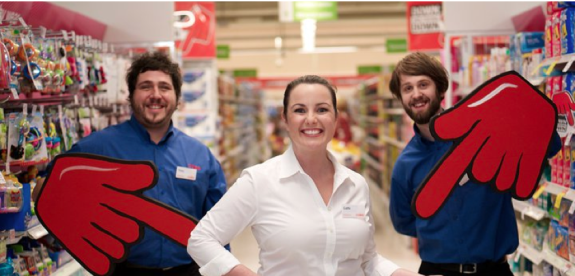
We are increasingly bomdarded with ads produced in-house by Australia's retailers, further driving standards down, down. Over 30 years creating ads has taught me great creativity sells. Especially when developed by local writers and art directors who are in touch with the essence of what makes Australians tick. I believe clients are best served by ads that tap into human insights, no matter how small. When told with humour or compelling gravitas a human truth will cut through where so called big ideas with big budgets and big name stars fail to connect with real customers.
Are you more inclined to buy from someone you like? I know I respond better to brands that have an endearing conversation with me, rather than a list of claims shouted at me, even when put to a jingle. The answer to appealing to customers doesn't lie in more data.
Sir John also warned about the dangers of data and analytics –
“Clients are desperate for salesmanship to be a science. They would love it to be. They would love to be able to say this equals that and this will be the return on investment so let’s do it. But they can’t. In the end it’s a judgment call you still have to make.”
Lets all hope more advertisers re-embrace the power of creative story telling, it makes better viewing.
Read MoreCustomer loyalty in Australia comes at a different price to O.S.

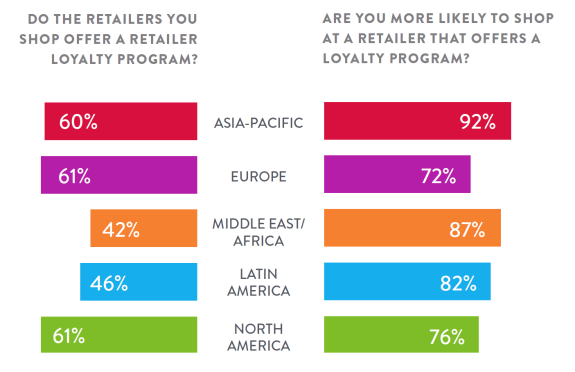
Our region ranks 1st in responsiveness to loyalty programs
We now have proof customers in the Asia-Pacific are the most willing in the world to reward businesses with loyalty. Whether you are in a service or product category, the good news for Australian business managers is your customers' loyalty doesn’t have to come at the price of discounting.
Don’t think global when marketing local
You can out-maneuver big brands that continue applying globally what works in their home market. Consider implementing strategies that Australian customers will reward with loyalty.
The US is introspective, remember it's the country that has a World Series with only US teams. Most US companies don’t have our local market's needs on their radar. Meanwhile, Europe’s big brands are struggling at home with a deflationary market. These parochial management mindsets offer Australian brands an unique opportunity. It's the perfect time to think and act local where big global players have a tendency to universally apply one strategy.
A global survey now shows us just how different Australian consumers are compared to the home town customers of global brands.
The Neilsen Global Report of Loyalty shows our customers are different
Unlike Europe and the US where 82% customers want discounts and free products as a reward, in our region we are less motivated (70%) than anywhere else by something for nothing. Here customers lead the world in valuing good customer service (53%) and exclusive deals (41%). The Customer Loyalty Report shows your customers want you to give them quality and service more than just price:
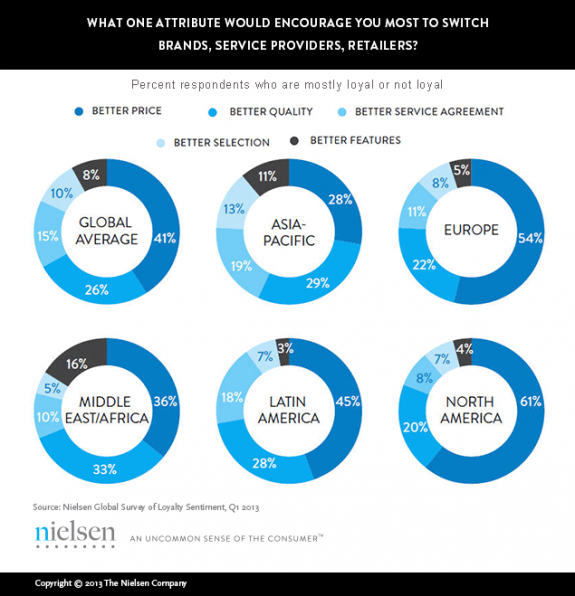
Loyalty programs can improve profits
UNO applied the disciplines of building a loyalty program around quality and service for Vivien's Jewellers. We replaced monthly cardboard in-window price promotions with quality themed creative store merchandising. We introduced a VIP loyalty program that emphasised exclusive product offers. Sales, discounting and price promotions were no longer frequent, being replaced with special occassion sales through invitation-only Wednesday night store openings. While Angus & Coote and Michael Hill were seen to be always on sale, we built a reputation for accessable aspiration.

Over 5 years we transformed Vivien's sales base from only 25% repeat sales to 75%. This also helped Vivien's double the number of profitable stores and ultimately sell the business at a category premium.
I continue to encourage our challenger brand clients to compete with the global competition by developing marketing strategies focused on what customers really value. The big guys often lack the ability to get close to the customer, let alone respond. You may have noticed over the last year a number of visiting global FMCG heads lamenting how hard it is for them to make money in the Australian market. Coles and Woolies forcing them to cut margins isn't helping.
Do you cut for share or innovate to grow?
Increasingly businesses nimble enough to canibalise their existing sales by trialing new products or services will gain market share in the long term. And because they aren’t discounting, those sales can be more profitable.
Spend your time looking at ways to make your customers feel understood and then invest in a creative communucation of your differentiated proposition. Let the global brands discount their way to local irrelevance.
Read MoreFrom the people who gave us wooden pillows – brand differentiation

Do you think it’s hard to differentiate in your category?
 A trip to Japan gave me a fresh perspective on how to make any brand stand apart from the competition.
A trip to Japan gave me a fresh perspective on how to make any brand stand apart from the competition.
Last month I bought a new mattress from David Jones Sydney city store. Each brand had the same proposition: sleep soundly and wake refreshed. Choose between hard or soft, affordable or expensive.
Talk about a lack of fresh ideas, the promise of a good nights sleep hasn’t changed since I worked on the Simons mattress account 30 years ago, or the idea of looking after your back when I marketed Sealy “Posturepedic” 20 years ago.
The Japanese have a strange way of looking at brand propositions
At least on first view this first world nation has some peculiar ideas about brand messaging. The English language isn’t used by 999 out of 1,000. And Japan has a proud history of maintaining thousand year old traditions. So this different background means common products are often promoted in totally different ways to our western approach.
A couple of weeks ago I checked out the merchandising of mattresses in a central Tokyo department store. Here are some pictures I took when the salesman wasn’t looking – mattresses marketed the way Nike sells shoes.
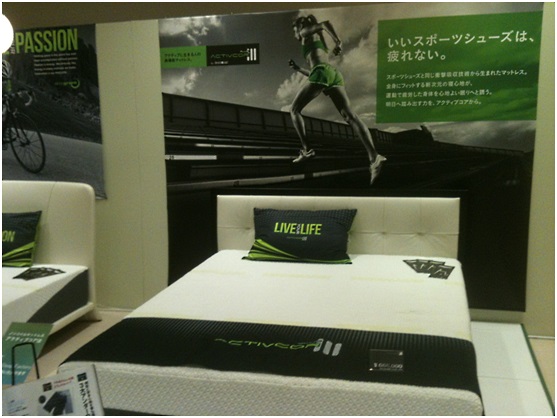

Nothing soft and fluffy about this positioning – “Activor, the next generation in sleep technology.” Hi-tech performance for the modern Japanese consumer.
Feeling inspired? Whatever your category, you can find inspiration from taking a completely different perspective.
P.S. Aussie mattress brand repositions for export market
Local mattress maker A H Beard has just launched in China. Unencumbered by any legacy in this new market, how are they differentiating? Their first mattress for Chinese consumers retails for over $20,000. That should set them apart.
Read MoreVale Scott Kennedy – one of NZ's finest artists
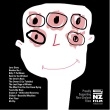
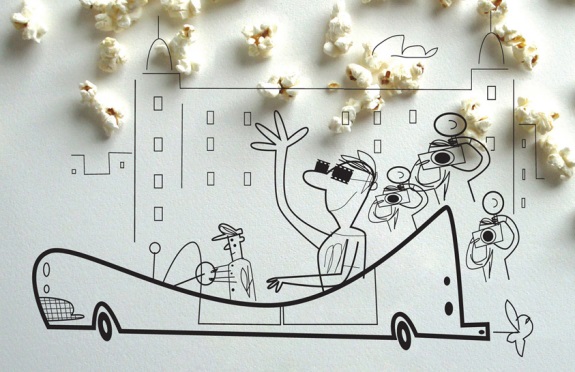
Our professional careers are sometimes touched by the most inspiring personal relationships. I was blessed with the early entry into my life as an Art Director by an artistic genius from across the ditch, Scott Kennedy. It was the early 80s and any Kiwi artist of promise had washed up in Sydney seeking a broader canvas.
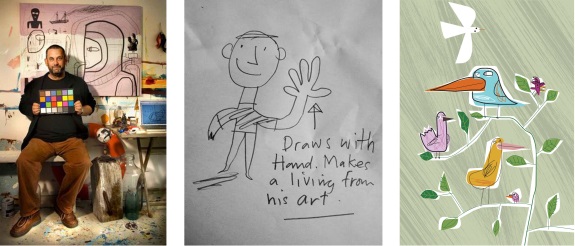
Scott bid us goodbye last week after a painful but defiantly good-humoured fight with cancer. At the end his hands wouldn’t work, but Scott’s creativity was always alive in his one of a kind headspace.

As you can see Scott’s view of life was re-expressed through the lens of 60s cartoon characters and tin toy robots and Dr Strangelove. His ex-US Army dad had relocated the entire family from California to New Zealand in the belief it was the safest place to be when they dropped The Bomb.
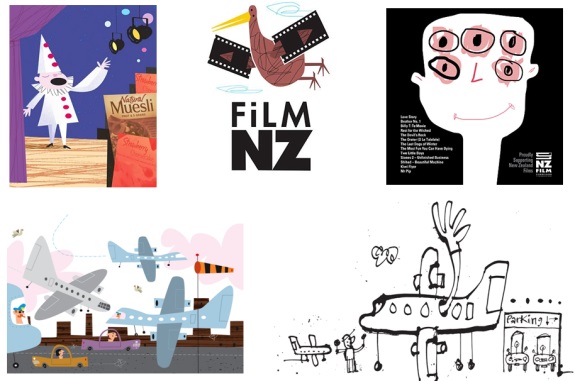
I loved Scott for his quirky humour, big heartedness and child like enthusiasm for new creative possibilities. Have a Captain Cook at Scott’s book covers for the popular How to… series, no surprises which is my favourite.
I write this while wearing Scott's "Joy kills sorrow" T-shirt, which is a fitting memorial to his precious time with us.
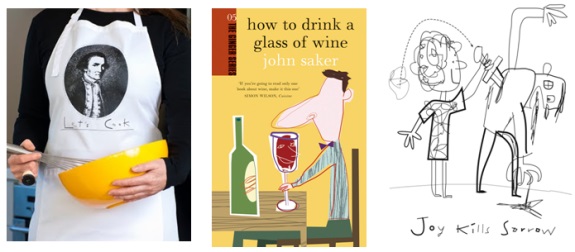
What CEOs want from an agency


The top 3 things CEOs and CMOs want from their agency according to a survey by the Communications Council are:
1. Innovation and creativity
2. Leadership
3. Integrity
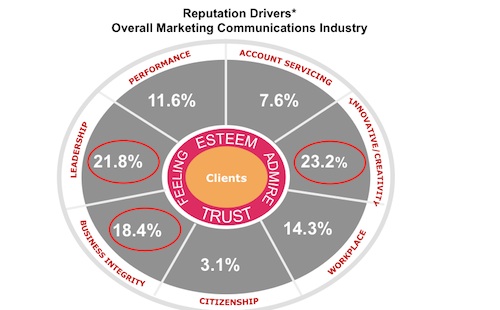
Funnily enough, the leaders of agencies put Leadership last.
Which could explain why three quarters of CEOs don't value marketers at the board level.
I wonder if this is a reflection of the transaction based relationships most agencies seem to be stuck in today. Whatever happened to “fearless advice”. It's what most left brain business managers want from right brain agency creative thinkers. Creative thought leadership is where agencies add value, not servile account management.
Perhaps it’s a consequence of a co-dependent relationship between ignorant brand managers and subservient suppliers. Meanwhile the smart business leaders appreciate the real value to be added is at the board level, with lateral and entrepreneurial advisors from outside their organisation helping them challenge traditional business models.
Read More

You may have noticed late last year the AANA broadened their official definition of “advertising” beyond that of a paid-for message. To reflect the changes the Internet has brought about, they now refer to “marketing communication” activity as brands are now often engaging in two-way conversations, not just pushing messages one-way via ads.
Early this year CommBank’s CMO Andy Lark, an ex PR man himself, told PR agencies they risked losing their traditional area of expertise to digital experts and integrated agencies.
The issue for businesses isn't simply which external supplier or internal staff is running your social media. With new technology comes a lack of control over how customers choose to seek information and engage with you, which brings a new level potential for confusion. And just as there is confusion around whom within a company or it’s preferred communications partners should be in charge of the conversation, the laws we all operate under right now are equally confused.
Who is responsible for comments posted on your business Facebook page?
In response to an ACCC ruling and fine of a liquor brand for leaving comments on it’s Facebook page deemed to he inappropriate, the AANA extended the reach of its Codes to cover most forms of advertising and marketing communication over which the advertiser or marketer has a reasonable degree of control.
In two recent determinations dealing with brand-owned Facebook pages, the Advertising Standards Board (ASB) reflected the AANA’s intent and stated:
“The Board considered that the Facebook site of an advertiser is a marketing communication tool over which the advertiser has a reasonable degree of control and that the site could be considered to draw the attention of a segment of the public to a product in a manner calculated to promote or oppose directly or indirectly that product."
"As a Facebook page can be used to engage with customers, the Board further considered that the Code applies to the content generated by the page creator as well as material or comments posted by users or friends.”
While you may think this ruling is a bit rough, at least you know where you stand. Until this week.
The AANA at least gave clarity, we now have a contradictory new set of guideline by the IAB
“After a careful analysis of existing laws and regulation and industry practice around social media IAB Australia has reached the view that user comments directed towards an organisation or social media platform, or to other users who are drawn to a particular organisation, do not constitute advertising,”
According to Samantha Yorke, director of regulatory affairs at IAB, “There is a real risk that organisations who treat user comments as advertising will err on the side of caution and moderate user comments very conservatively, which will adversely impact their presence on social platforms and which arguably undermines the very spirit under which social media thrives,”
I wonder what a judge will say about a marketer’s immoderate management of a social media campiagn in a yet to be held ACCC hearing?
UNO is one of a small number of marketing communications agencies accredited by The Communications Council of Australia. We believe self regulation only works when all of our customers' messages within our control are held to the same highest standards of paid-for and signed-off ads, irrespective of whether published in a traditional, new or yet to be invented medium. At least that way our clients have minimised their risks, both known and unknown.
Read More
There are many tips and how to guides claiming they have the key to revealing the relative strengths and weaknesses of where to advertise, promote and connect. Media sales reps have a long history of presenting charts and graphs that show their medium in a favourable light. To ensure the best ROI marketing, we only rely on those studies that have rigorous methods and meaningful numbers to make the findings reliable.
Don't trust every media benchmark you can Google
For those who want to know what medium is most effective at acquiring new customers in the digital era, here is a chart we feel is valid:
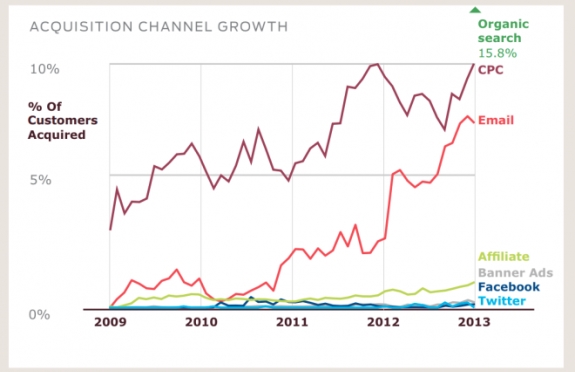
Trend in performance of digital channels for acquiring new customers
Custora came up with these figures by analysing data from 72 million customers shopping on 86 different retailer sites. They tracked where customers were clicking from (email, Twitter, Google, etc.) and what and how much they bought, not just on that visit but for the next two years.
Over those two years, Custora found that customers who came to retailers from search were 50 percent more valuable than average. In other words, they were more likely to shop more and spend more. Email customers were nearly 11 percent more valuable than average. Customers who came through Facebook were just about average. Twitter customers, meanwhile, were 23 percent less valuable than the average during the two years following that first click.
I've written before that our reluctance to spend clients' money on banner ads is based on one amazing fact: you are more likely to win Lotto than click on a banner ad.
In comparison to these digital channels, research by the Direct Marketing Association shows you may still be best served with good old direct mail:
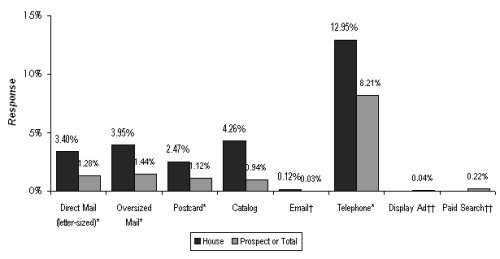
Average response rates for direct sales, DMA 2012
There is one new piece of research though that ultimately makes the discussions about differences between media effectiveness become a secondary consideration. It's proof of what many of us have always suspected.
How you craft your message is more important than the medium
The latest research into advertising effectiveness in Australia has proven creativity makes a big difference. The Association of Data-driven Marketing & Advertising shows that after 12 months ads with better ideas are both more effective and increase a brand's ability to harden pricing.
This reminds us you’re potentially wasting your time and money if you don’t get your pitch right. As consumers we remember big ideas, like “Think small.” Or the pulling power of a well crafted headline like “It’s Time.” Or a picture worth a thousand words...
The truth well told has been proven yet again to be more important in getting the best ROI from your marketing than any optimisation techniques digital specialists may dazzle the bean counters with. We are not animals, we are human, and we respond to emotions, not numbers of targeted exposures.
For those who want to make the most of their investment in airtime/space/or face-to-face, remember to invest a little in the art of communication.
It's not just consumer brands that can benefit from better communication
An ability to express your message is just as impotant for both service businesses and B2B. This is especially true for financial services, as shown by this chart of what customers say are the most important qualities in a financial adviser.
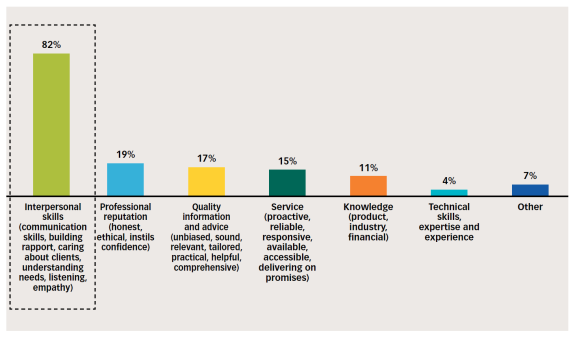
AFA White Paper: The Trusted Adviser May 2013
The report found the biggest difference in success of the top 10% of financial planners and the rest isn’t expertise, or credentials or technology – it’s the ability to communicate. Communication is not talking at people, it's the art of speaking with empathy. This is where social media excels. Use it to listen to your customers, then respond in a way that makes the individual believe you understand where they are coming from.
Irrespective of digital or traditional, face-to-face or in writing, where you have the conversation is secondary to the way you express yourself.
Just remember to make the message suit the medium. Our burping cow ring tone for Sipaah was downloaded by lots of kids who knew exactly where our brand was coming from.
Read MoreFame is the game of the name


The exponential pace of change is increasing the pressure on businesses to stay competitive. You know it’s not going to slow down. Fortunately there are still ways you can take control. One proven method is to revisit some simple building blocks to help make your brand relevant in today’s complex marketplace.
4 step process to make a challenger brand famous:
GAME
NAME
FAME
CLAIM
Game:
When did you last define what it is you do you do that makes you a specialist. In a cluttered business environment it pays to play in a defined niche where you know more about the rules of the game than your competition. Define the things that are of value to your prospect. Make sure you understand what it takes to be world’s best at your game, and work to stay at the top. People will still pay you a premium for something special that means something special to them.
With a fresh outside perspective, define your true differentiators, your “authentic truth.”
Name:
Your reputation, the brand and everything it does must be aligned with what you do that is special or your efforts will be diluted. Today, any business with integrity can compete against established incumbents. The cost of entry is no longer big budget mass media campaigns, the spoils now go to the nimble.
Today, the truth is what counts, the public can find the facts faster than businesses can attempt to shape opinion. Ensure your brand reflects your truth in everything you say and do.
Fame:
The art of being noticed. And remembered. And talked about.. You can do this several ways. Spend a lot of money, like Swisse, who invested up to 60% of annual revenue to marketing to achieve business growth, which stands at about 50% year-on-year over 4 years.
Or take the stand out in the crowd approach. An elevator pitch is only of value if people are listening, be too polite and you will be invisible. There is something to be said for the fart in a lift approach, however can you risk going viral with the wrong tone of voice?
Ideally, you can take the hero approach: be noticed by the right people for the right reasons. To do this ensure you choose the right medium for your message. There have never been so many communications options – a pitfall for the unwary, and an opportunity for the savvy
Claim:
Tell the truth, especially now the customer can search the Internet to discover what is a genuine claim and share with their friends what they find out. Decide what will differentiate you in your game – do you do it faster or smarter, cheaper or better?
Then find a creative way to express your difference. As J Walter Thompson said almost a century ago, “the truth well told” is the value add of great advertising.
Famous campaigns start with a defined customer benefit
What’s your “Which Bank?” How will you enter the vernacular, as this one of mine did 25 years ago:

With a creative leap, you can express the human insight that will resonate with your prospects. And they’ll repeat it to friends, again and again.
Read More
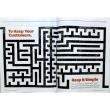
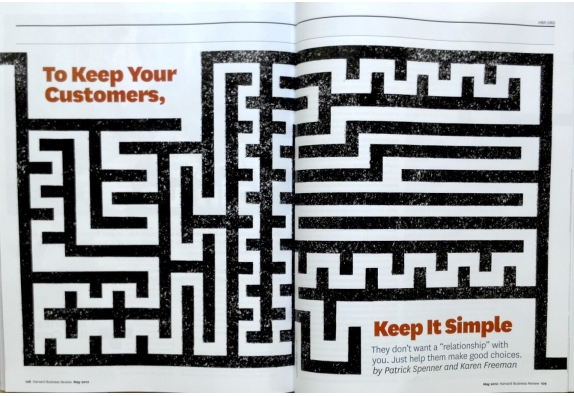
How do you explain to the manager who signs off your budget that today customers want more from your website than a brochure online? You can start by pointing out how you can replace existing fixed and recurrent costs with keener priced digital alternatives. Then remind the cost controller that technology is moving so fast they’ll be surprised how much more you can do today for less. A lot less than many of the savings to be made across existing business practices that digital can now enhance or replace. This 12 point digital checklist can help you keep it simple and the returns substantial.
Your digital project 12 point checklist
Keep an open mind, what the site needs to include is based on what the customer wants, don’t limit scope by prescribing whats to be included by your what your preconcievd ideas of what the competition have already done.
Engage with the user in the context of where and how they are accessing you. Are they on a mobile while in a shop, in bed on a tablet or at their workdesk on a PC? At work, at home, on the move, your site experience needs to change accordingly.
Educate or entertain? Ask yourself are they visiting your site to learn more, or simply because it is an enjoyable experience? Or would they like it if you did both? Deciding this helps shape your content and navigation.
Personalisation. "Allow users to personalise their experience. People love to add personal touches because it helps them feel at home and in control. Provide sensible, beautiful defaults, but also consider fun, optional customisations that don't hinder primary tasks." - Google Android
If you don't treat each customer as an individual, a competitor will. Technology now enables you to serve each visitor exactly what they want, a bespoke site just for them.
Innovate.The digitisation of everything now allows you to reinvent so many of your business functions and methods, take advantage of what is now possible.
Tone of voice is more important than what you say. The way the site looks, the colours used, typography, whether there are pictures or videos and the style of vocabulary you use will make a bigger impression about your brand image than what is in the text.
Services is what you build today, not websites. "Our service doesn’t begin and end at our website. It might start with a search engine and end at the post office. We need to design for that." - GOV.UK
Iterative, our most used word to describe our process for scoping, designing and building a digital service. Start small, constantly evolve and develop the service offer. We learn and improve the offer together as we go.
Marketing. A site without marketing is an island resort that’s not on any map, let alone an itinerary. Don’t launch and leave, have a plan that will drive customers and prospects to your site, align what the promise is and how your site will deliver to expectations.
P, there are 4 of them in marketing: Product, Price, Promotion, Place. Consider which of the Ps is most useful to enable you to best engage with each type of customer. The 4Ps of marketing aren’t all the same for every person or every occasion.
Load time is more important than looking good. Too many fancy things can slow down the experience.
"Make important things fast: Not all actions are equal. Decide what's most important in your app and make it easy to find and fast to use, like the shutter button in a camera, or the pause button in a music player." - Google Android
Effectiveness. Know what you want to achieve and why. Most importantly decide how you will measure with meaningful metrics that can be acted upon. Then you can build in measurement techniques to track what is working and what needs to be improved. And make sure someone is in charge of tracking results and implementing improvements.
If in doubt about what matters most, remember the customer's perspective comes first. Look at the first letter of our 12 points. In an increasingly complex world, when you connect with customers they will appreciate it of you can KEEP IT SIMPLE.
Read MoreRadioactive ads from when people didn't know better

Classic ads from 1910-1930 for radioactive products
What can’t radium cure? A century ago it was legal to advertise radioactive products, from toothpaste to suppositories, condoms and check out the chocolate!
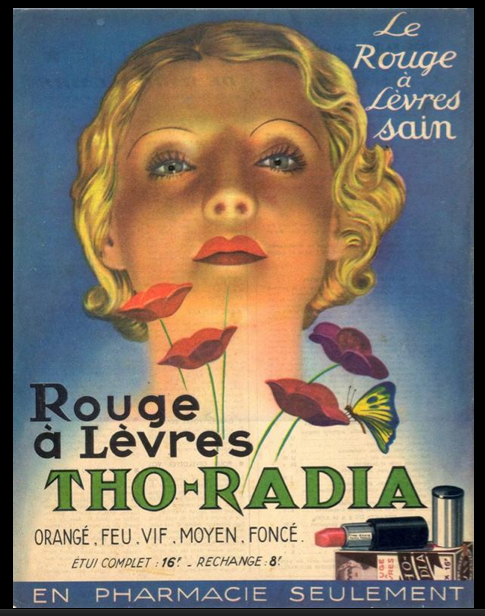
If looks could kill: Radium lipstick advertisement from the 1930s. (via 109.com)
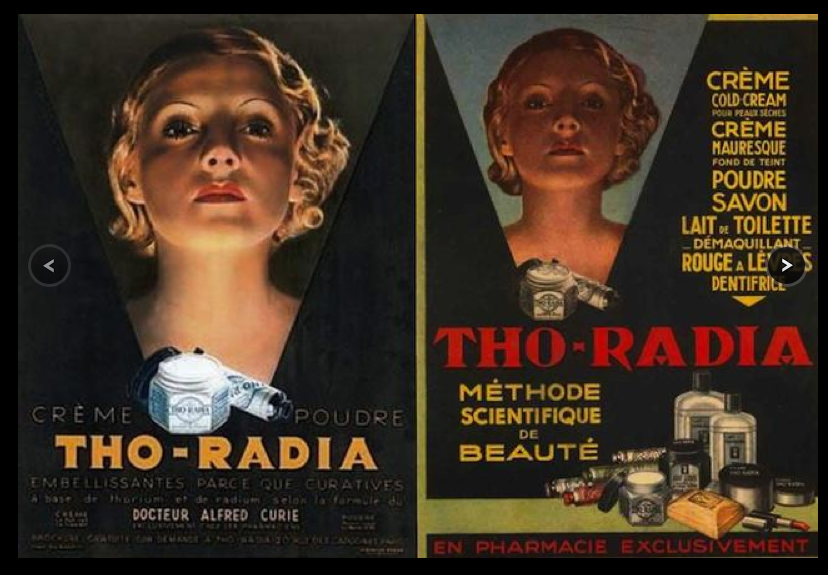
More classic ads from the 1930s for the Tho-Radia range of makeup.

Nil by mouth, guaranteed harmless?!! Gives new meaning to "the ring of confidence"
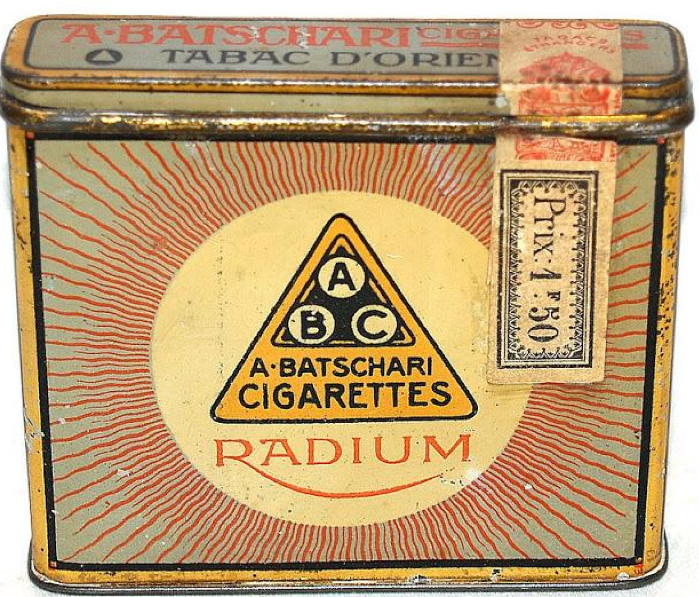
Anyhow, have a radium.
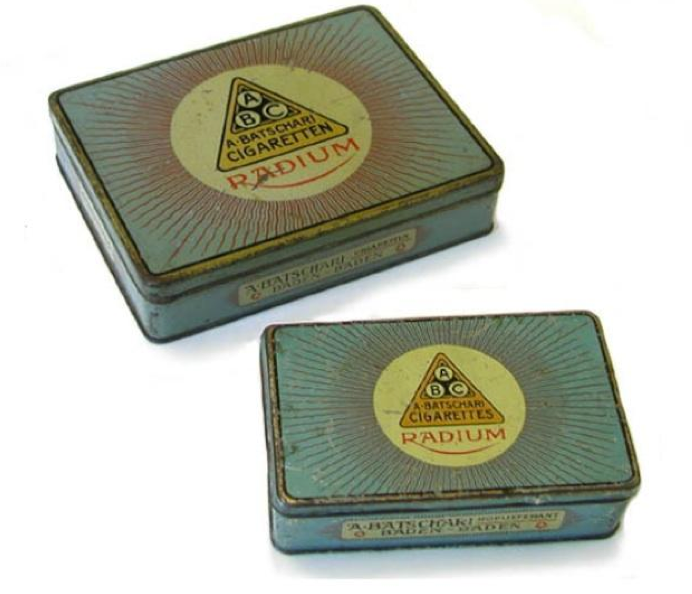
Now in a convenient pocket size pack of 20s. They didn't know smoking kills.

Mrs Marsh could give us a demonstration of the brighter effects on your smile of Radium toothpaste.

Chockaholics aren't left out, Radium is everywhere. The ads claimed eating a block would make you look younger.

Time wasn't on the side of those with radioactive numbered watches that glow in the dark.
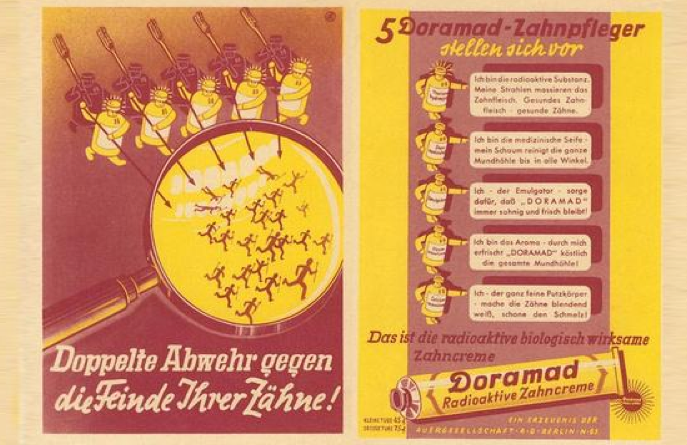
Another ad campaign competing for share of the toothpaste that glows market, now with added thorium.
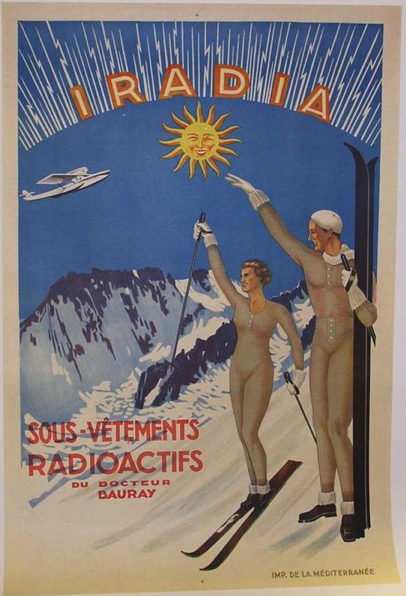
Radioactive wool keeps you warm on the slopes.
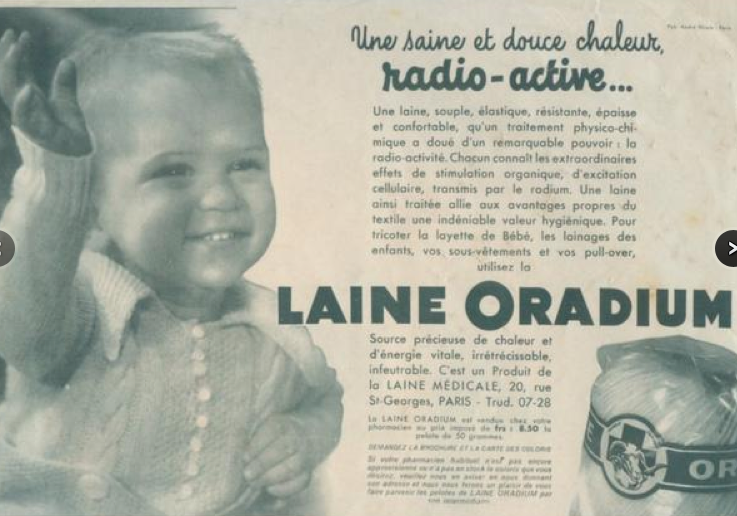
Dress your baby in it.

Advertised as a cure for arthritis, rheumatism, mental illnesses, stomach cancer and impotence. (via Real Food University and Oak Ridge Associated Universities) Triple distilled, who needs a whickey chaser?
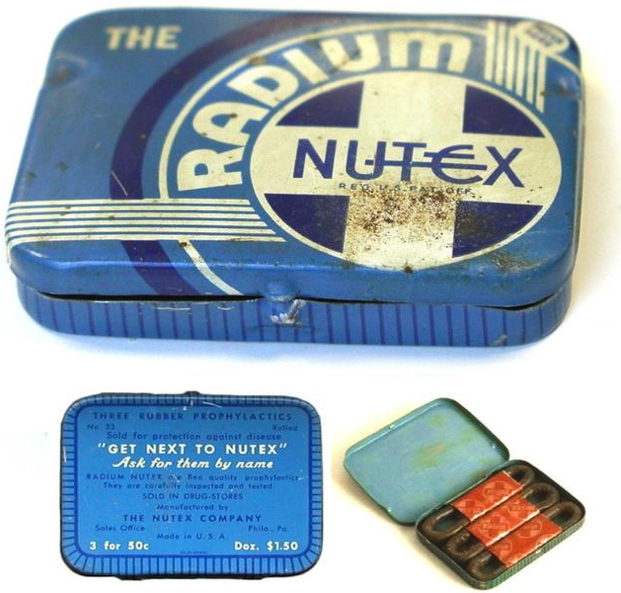
Condoms, that glow in the dark?
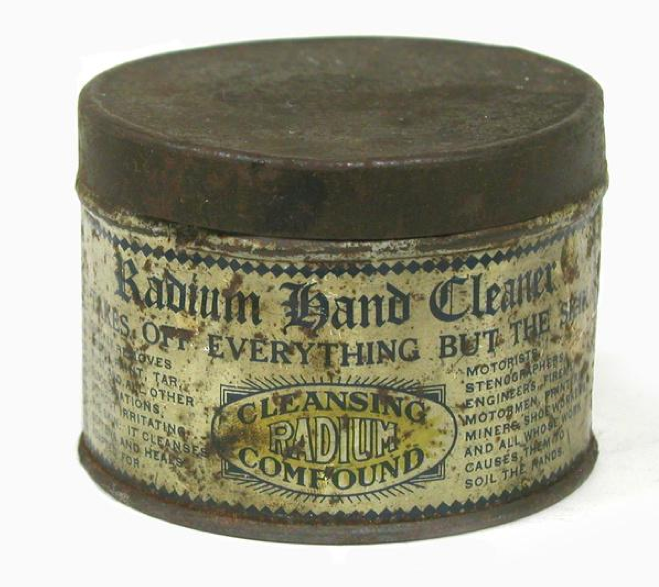
They didn't realise you can't wash off radiation poisoning.
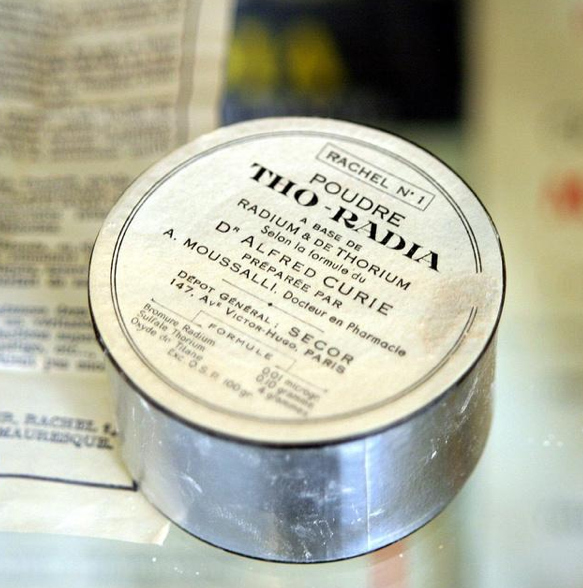
Dr Curie started something big. Cosmetics companies continue to claim they have the secret to eternal youth.
Like to see some more classic ads?
Have a look at 12 great vintage politically incorrect ads for Christmas gifts.
Read More
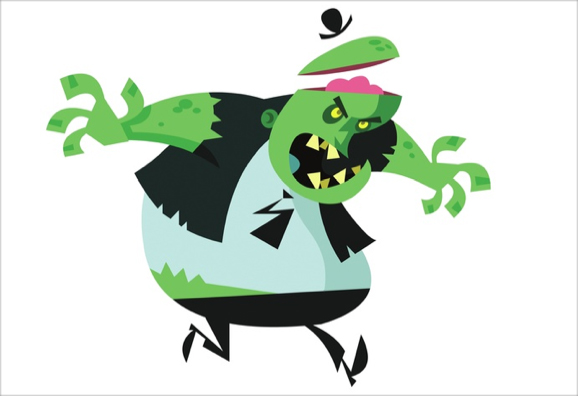
Everyone knows the way to lose weight is to eat less and exercise more.
Yet year after year most Australians are getting fatter. Fatter people aren’t as healthy. Fatter people die earlier than fitter, leaner people.
A whole industry makes money out of fat. Fitness clubs. Personal trainers. And diets. None of it works over time. The stats prove it. It’s not enough to know you have a problem. Personally I have never been better educated, yet I’ve never been so overweight.
Science has shown only cognitive behavioural therapy ensures long-term positive change and a healthier longer life as an ex-fatty. 21 days of mind reprogramming is just the start to breaking the usual fatso habits.
Business as usual doesn’t work. How long till the business you work for dies?
Australian businesses are fat. They aren’t fit enough to cope with today’s rapid pace of change and increasingly complex issues. They don’t exercise their brainpower by trying something new. And like most of us with a weight issue they are looking for the quick fix. So they outsource it.
The diet industry equivalent in this instance are the service providers, from the Deloitte pre-prepared meal programs and the peddlers of management boot camps, to the efficiency fitness trainers selling the benefits of Sigma 6 and Lean. Even the language is the same as The Biggest Loser.
The answer for struggling businesses isn’t in doing the same things more often, or paying more personal trainers to lift your motivation. Nor is it enough to reduce the excess fat by cutting costs. Stomach stapling the business results in staff suffering reflux, hunger pains and mental stress for no performance improvement.
The answer is cognitive behavioural change.
The answer is developing an innovation mindset.
Here’s how it works and why most businesses are doomed to die early.
It starts with the owners of the business recognising they have a problem. An attitude problem. Their brains have been thinking the same way so long their synapses have turned a well-worn groove into a rut of superhighway proportions. The problem is, it’s now a road to nowhere.
The new business opportunities aren’t where the brain has become accustomed to drive to, every category is seeing their marketplace become a ghost town. Today’s marketplace is somewhere new, and management not only don’t know where it is they don’t have a map to show them how to get there.
The new destination is growing, profitable and exciting. It’s enabled by the Internet and feeds on new ideas made possible by software as a service, unified comms and the cloud. The new place isn’t a city or a country or a category, it’s everywhere and anywhere the customer happens to be, 24/7. Now every customer or prospect can pick and choose what they want via a mobile device. From cat food to cars, retirement plans to restaurants, you can research and purchase without talking to a salesperson.
Yet business owners continue to think the value of their business is existing fixed assets and legacy systems, current supply contracts and distribution arrangements, proprietary processes and procurement systems. Australian managers continue to tweak a little here and there around the edges of their business models. Generally, the bigger the organisation the more cholesterol blocked the arteries of internal management and external communication.
Figuratively speaking, fat dead men walking the corridors of offices around the country are about to be knocked off by fit and nimble female and new age male entrepreneurial thinkers who are open source and open minded.
So what do our business leaders do? They buy another diet book, like the biography of Steve Jobs. What they don’t realise is reading about Apple is as relevant to middle managers as middle aged men reading about Usain Bolt’s exercise regime. Apple was a challenger brand from day one. It was in the DNA.
The answer isn’t reading a book on what someone else has done. It comes from doing what hasn’t been done. It comes from the confidence to try something new with a willingness to fail. Accepting you’re likely to fail again and again. Because continuing to do what you do now is guaranteed to fail. While with every new thing you try your chances of discovering a winner increases.
Changing your habits and practicing to do what doesn’t come naturally, every day, is the proven method for success. It’s making a habit of taking small risks often so you don’t stand still and become another Kodak. The proof is in understanding how Fujifilm could innovate itself a future as a cosmetics company.
Memories might be priceless, they just don’t make money like they used to.

How a traditional business became a challenger brand
Fifteen years ago Kodak entered a death spiral, from a global peak in 2000, camera film sales dropped 90 per cent in 10 years as the digital revolution swept the world. “We’d known it was coming since the 1980s,” says Yojiro Yamashita, general manager of Fujifilm’s life science products division.
Kodak didn’t make it, going bankrupt last year. Fujifilm not only survived but emerged into the digital world of today with a series of innovative new businesses.
Fuji recognised what its’ true strengths were says Tomoyuki Yamazumi, a cosmetics industry analyst for the research firm Fuji-Keizai. “It had the financial power plus a strong marketing ability and existing ties to consumers.” One of the small risks Fuji management took was launching a cosmetics range in 2007. By 2010, sales of Fuji’s upmarket Astalift brand were already over $100million a year. By 2018 the company is looking to increase skincare and supplement sales by ten times that.
Look around your business. Are you a Kodak, or can you recognise your strengths, try something new and innovate your way to a future as a challenger brand?
This article first appeared in AdNews, 30/5/13
Read More

At CeBit 2013, Salesforce Vice President Vivek Kundra’s big question for Australian leaders is “how can a country of 22 million people compete in a world of seven billion?” His answer?
“It’s not about size. It’s going to be about innovation. Innovation policy and an innovation agenda have to bethe come building blocks of a nation that’s going to compete in the global economy.”
Third wave of computing is changing the global economy
Competition in the global world of business is being driven by a ‘third wave of computing’. Essentially the shift from hardware to cloud based software and services and super fast mobile broadband networks that allow consumers and workers to access data on portable devices. Our clients have seen a doubling of visits to their websites from mobile devices over the last year. In fact, this year more people globally will access the Internet from a mobile than a computer.
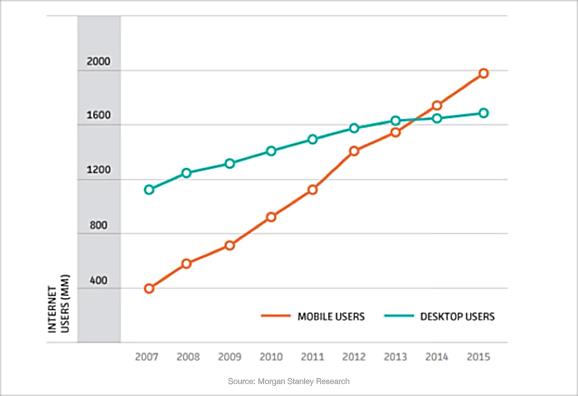
The opportunity for challenger brands
The biggest risk for businesses I’ve observed are the internal stakeholders defending their hard fought for legacy systems and infrastructure, and managers who are obsessed with efficiency through fine-tuning traditional methods. As Kundra points out, competitiveness now comes from letting go of what you’ve currently got now. “Most large scale organisations are still stuck in 1980s technologies. If you’re still stuck in an old mindset then unfortunately there’s a young entrepreneur who is imagining the way the world should be rather than it is.”
“The most amazing opportunities lie in reinventing entire sectors of the economy.” Vivek used the usual examples of US companies like Amazon, Netflix and Uber as businesses that are challenging categories today.
If you are running a business you have a clear choice he says – “do you want to be Amazon or Barnes & Noble?” This isn’t a particularly new view, as a global survey by Boston consulting summed up a couple of years ago, in this world of rapid change the spoils go to the nimble. Still, many managers still don’t seem to be responding.
“There’s a Darwinian spirit to the extinction of those who are holding onto the 1960s ways of doing business.” Vivek states, “not because it’s in the interest of the customer but because it’s easy and it’s because that’s what they know what to do.”
A marketer’s mantra for today: “The customer. The customer. The customer”
This is the biggest differentiator for challenger brands. “Companies that are embracing the third wave of doing business are doing it in the interest of the customer.”
Kundra recognises the fear of change within businesses when he suggests the best way to introduce a change culture is to build a prototype. “I think for too many people the expectations for transformative technologies is that it takes too long, costs too much and they’ve been burned in the past.”
A test and learn approach reduces risk
Last week at the launch of an AGSM Mid-Market program a professor specialising in innovation for business pointed out success today comes from having a portfolio of new initiatives that can be tested quickly in the marketplace. Rather than over researching only one strategy in an attempt to minimise risk, be willing to fail and fail frequently. The chances of some prototypes being winners with the customer will increase the more you try.
As Kundra says, aim to “be relevant and simplify the customers’ or citizens’ lives”.
Read More

The latest statistics on online fashion retail sales, research on the main purchase driver for financial advice and a Californian think tank pricing model all give marketers strong reasons to reconsider Price as a useful tool.
Evidence 1: Online fashion sales prove price not the motivator
No wonder Australian retailers are scared of online stores. British online retailer ASOS recently revealed that Australia is its single largest foreign market — with Australians buying something from the ASOS website every 6 seconds. The latest research from Roy Morgan shows at December 2012, 7.6% of Aussies aged 14+ (or 1,430,000 people) had made an online fashion purchase in any given four weeks — up from 5.7% (1,062,000) one year earlier.
Online fashion-purchasing habits by Australian women by sub-category, 2011-2012
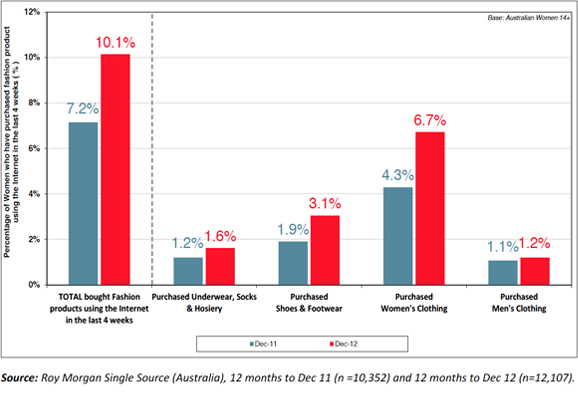
What is really interesting is the opportunities for marketers this research reveals. Most people would probably jump to the conclusion that these online sales are being lost by Australian stores because clothes are available cheaper from overseas. Everything on the web is cheaper, right? Well actually, no.
Roy Morgan’s research has found “scoring a bargain is not the main motivation for women purchasing fashion products online. Far more important is quality, with 75% of them agreeing with the statement ‘I believe quality is more important than price’.”
Discretionary spending by women on clothes has parallels with the way men seek financial advice. A recent national survey by an independent network of financial advisors found the vast majority of customers were more concerned about the quality of service and the frequency of face-to-face time they received than the size of the fee. Of hundreds of customers surveyed, price was rarely mentioned. Value was the primary concern, and the value equation was grounded in the perception of the quality of advice. .
None of this is new. I’ve been segmenting customers using the New Economic Order for nearly two decades since it was first developed by two Australian academics.
Evidence 2: choose who you want to be your customer
You can segment the population by three distinct sets which allow marketers to predict discretionary spending behaviour. The biggest segment, the Traditionals, sre generally cash poor with most of their spending accounted for with essential services, utilities bills, rent, transport and food. They have neither the capacity nor the predisposition to purchase discretionary items.
The other half has a common mindset, they share a desire to buy quality goods and experiences. This group is divided in half by their capacity to spend, one half are NEOs, and while they are only a quarter of the population they represent half all discretionary spending. Transitionals are NEOs on a limited budget: a career couple with one at home with a baby, or a high achiever that's just started their own business, or perhaps they have retired.
For 50% of consumers, the Traditionals, a cheap price is their opening and closing consideration. However these are the people who don’t spend much. They also deliver no sense of loyalty and don’t refer new customers. Every sale to a Traditional is a new sale that starts from scratch. And risks going to the lowest priced competitor on the day.
Most restaurant and airline customers and B2B purchasers are NEOs. These people research purchase decisions on the basis of what they believe are the features and benefits that mean the most to them. Price comes LAST, and isn’t much of a deal breaker.
Those latest stats on online fashion sales make sense in light of NEO behaviour. NEOs are online researching what’s hot in the world of fashion. In fact, it’s where they do most research when considering any major purchase because it’s where they control the levers, avoiding the unsavoury hassle of being sold by a salesman face to face. While Traditionals continue to spend the majority of their clothing budget on essential items like socks and undies in stores when the sales are on, NEOs continue to buy more discretionary fashion items, more often, both from the Internet and instore.
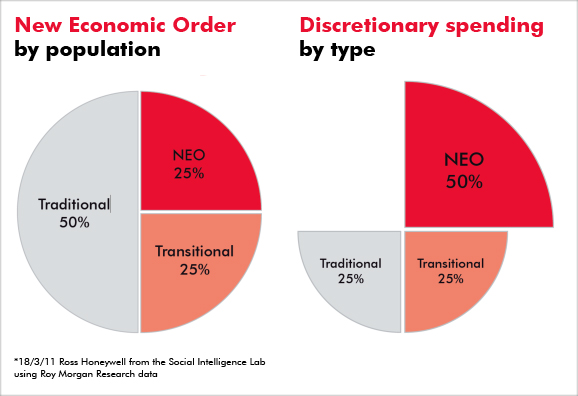
So what’s the best marketing model for selling to NEOs?
Evidence 3: all value is subjective
According to Ron Baker, the founder of Californian think tank the VeraSage Institute there are two fundamental approaches to pricing:
Cost-Plus Pricing
Labour Theory of Value
Product » Cost » Price » Value » Customers
Pricing On Purpose
Subjective Theory of Value
Customers » Value » Price » Cost » Product
You can see how subjective value pricing turns the order of cost-plus pricing on its head, by starting with the ultimate arbiter of value – the customer. In Baker’s words: “Goods and services do not magically become more valuable as they move through the factory and have costs allocated to them by cost accountants. The costs do not determine the price, let alone the value. It is precisely the opposite; that is, the price determines the costs that can be profitably invested in to make a product desirable for the customer, at an acceptable profit for the seller.”
As a marketer, for decades I found software one of the simplest products to approach from the Pricing On Purpose model; it’s the only reason Microsoft had education, standard and professional versions. The mid range product best reflects a fair margin for the cost of production of the product. The same product is then also sold at a low entry price with a few features turned off to maximise sales volume at the low end and repackaged in a fancy big box with a few extra features to maximise margin at the upper end of the market.
Choose who you want your customer to be, only then pick a marketing P
Whether you are selling clothes or cars, fair trade coffee or boutique wine, building materials or investment services, remember when your sales force wants you to discount, ask them to stop and think about the customer. Are you selling a basic product to a student, an authentic experience to a Transitional or a professional service to a NEO? Agree with sales who your customers are before you decide to use the PRICE lever.
Depending on who your customer is, Product, Place or Promotion may be more valuable to them than Price.
Read More

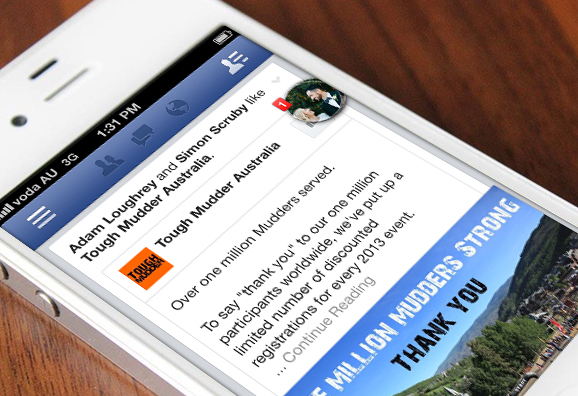
Just being active on Facebook isn’t enough. As with any communications medium, there are smart ways to achieve more for less effort.
Don’t be baffled by social media marketing spin doctors. Sure, Facebook has it’s own set of best practices. Hopefully by getting to know what matters and what doesn’t you can ensure any supplier will make the most of your investment.
The key to making the most of Facebook for your business is understanding it’s all about making sure everything you do improves your chances of being seen.
Much of this isn’t about paying for black art, it’s about basic step by step craft.
40% of time on Facebook is spent on news feeds
Only 12% is spent on profile or brand pages. So:
- Post articles on other people’s pagesPost on less pages more often
- Choose pages with high numbers of fansPhotos have higher ranking than links or text
- Use images
- Keep your text posts short – between 100 to 250 characters get 60% more engagement
- Ask a question
- Post daily and frequently
- Post about relevant topics – don’t push the brand
- Test your audience for their engagement times – 18-24 year olds are most active 9pm – 10pm, women 25-45 even later
How edge-ranking works is the key for marketers
All of these individual steps are only important because of something called edge-ranking. This makes or breaks social media marketing. This infographic shows how it works.
Read MoreThe health checklist for your sales process

15 questions to help your business determine the focus for your sales activity.
Do you have a sales department? Here are 15 questions to help change your sales force from sales takers to sales makers:
- How much time are you investing in new business a day?
- Is the total revenue and the sum of your clients’ budgets growing more slowly than in the past?
- Will growth levels come from present client budgets?
- Where will growth come from?
More frequency of purchase
More volume of each sale
More value? Up sell/or cross sell? - Will growth have to come from new business won from competitors?
- How do you sell to prospective clients?
- What’s your process?
- How do you find them?
- How do you win them?
- How do you prioritise sales calls?
- How is a sales call pre-qualified, (telesales/email/CRM)
- How long is spent face to face?
- What is your conversion rate?
- Is the sales call to the final decision maker?
- Who is the primary decision maker, how are they managed?
ROI marketing can help improve the performance of any of these sales metrics.
Marketing can speed sales, pre-qualify and build loyalty once you’ve made a sale.
In the past business owners were frustrated by an inability to measure what worked and what didn’t. Today there are tools and technques to enable you to measure the return on your marketing investment.
Read More




Scan the QR code for our contact details.
Download the Neoreader app.
© COPYRIGHT 2013 UNO marcomms Privacy